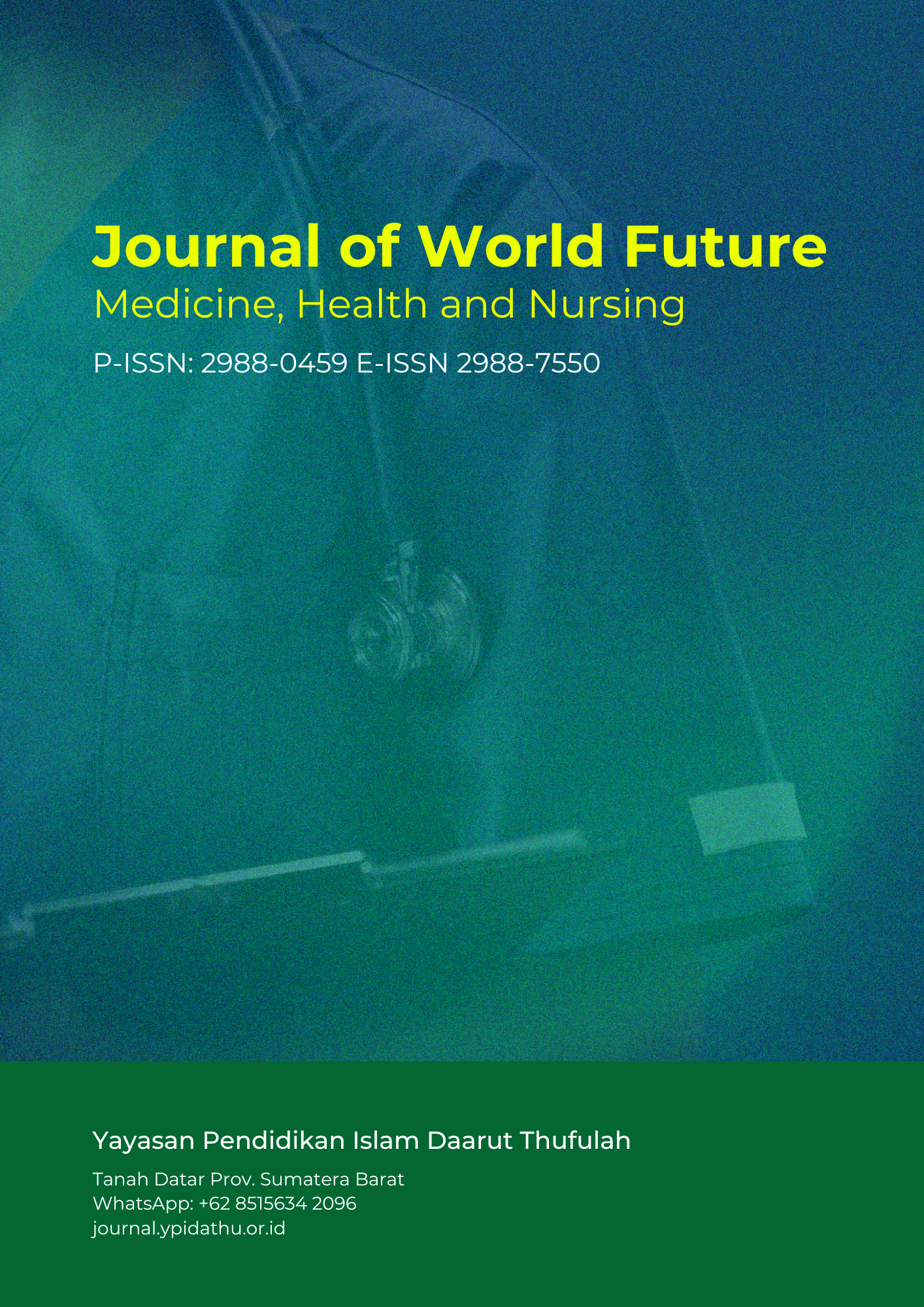The Role of Social Support for Psychology of Postpartum Mothers in Tembelang Primary Health Care
Abstract
Postpartum depression affects around 10-15% of all new mothers, but can be up to 35% higher in the demographic group. In developing countries, the prevalence ranges from 5-25%. 4 One study found 19.2% of new mothers diagnosed with major or minor depression in the first three months postpartum, 7.1% of whom had major depression. In another study of 214 women, 86 of them had symptoms of depression (40.2%), but only 25 (11.7%) were significantly diagnosed as depressed. The number of postpartum mothers in the Tembelang Regional PKM is 47 starting from January to August 2018. This study is an analytical study using correlation analytic design regarding social support roles for postpartum psychology in the Jombang District Auction Area PKM. Test of bivariate data analysis using spearman rho hhe total sample in this study was 47 samples with a total sampling technique. From the analysis of this study it can be concluded that it shows that the model variable has p value <0.05. This means that the social support role variable has a significant relationship to postpartum psychology. It is expected that the results of this study can be used as input for basic health services in the work area associated with early screening for postpartum maternal disorders through postpartum visits.
Full text article
References
Gaudet C., Wen W.S., Walker M.C. Chronic Perinatal Pain as a Risk Factor for Postpartum Depression Symptoms in Canadian Women. Canadian journal of public health. 2013;104(5): e375-e387.
Gausia K., Fisher C., Ali M., Oosthuizen J. Magnitude and contributory factors of postnatal depression: a community-based cohort study from rural subdistrict of Bangladesh. Psychological medicine. 2009; 39:999-1007.
Sadock B.J., Sadock V.A., Psychiatry and Reproductive Medicine, Text Book Synopsis of Psychiatry, 10thed. Wolter Kluwer/LippincottWilliams&Wilkins. Philadelpia. 2007:865.
Motzfeldt I., Andreasen S., Pedersen A.L., Pedersen M.L. Prevalence of postpartum depression in Nuuk, Greenland- a cross-sectional study using Edinburgh Postnatal Depression Scale. Int J Circumpolar Health.2013.72:21114.
Chandran M., Tharyan P., Muliyil J., Abraham S. Post-partum depression in a cohort of women from a rural area of Tamil Nadu, India. British journal of psychiatry.2002; 181,499-504 6.
Dennis C.L., Heaman M., Vigod S. Epidemiology of postpartum depressive symtoms among Canadian women: regional and national results from a cross-sectional survey. The Canadian Journal of Psychiatry. 2012;57(9): 537-547. 7.
Derosa N, Logsdon M.C. A comparison of screening instruments for depression in postpartum adolescents. Journal of Child and Adolescent Psychiatric Nursing. 2006;19(1):13-20.
Afiyanti, Y. (2002). Deteksi dan pencegahan dini postpartum. Jurnal Keperawatan Indonesia, 6 (2), 70–76.
Armstrong, K.L., Fraser, J.A., Dadds, M.R., & Morris, J. (2000). Promoting secure attachment, maternal mood and child health in a vulnerable population: A randomized controlled trial. J Paediatr Child Health, 36, 555–562.
Beck, C.T., & Gable, R.K. (2001). Further validation of the postpartum depression screening scale. Nursing Research, 50 (3), 155–164.
Beck, J.S., Vartuli, J.C., Roth, W.J., Leonowicz, M.E., Kresge, C.T., Schmitt, K.D., Chu, C.T.W., Olson, D.H., & Sheppard, E.W. (1992). A new family of mesoporous molecular sieves prepared with liquid crystal templates. J Am Chem Soc, 114 (27), 10834–10843. doi: 10.1021/ja00053a020.
Bloch, M., Schmidt, P.J., Danaceau, M., Murphy, J., Nieman, L., & Rubinow, D.R. (2000). Effects of gonadal steroids in women with a history ofnifas depression. Am J Psychiatry, 157, 924–930.
Campbell, S.B., & Cohn, J.F. (1991). Prevalence and correlates of postpartum depression in first-time mothers. Abnormal Psychology, 100, 594–599.
Cooper, P.J., & Murray, L. (1998). Postnatal depression. BMJ, 316 (7148), 1884–1886.
Djarwanto, P.S. (2001). Mengenal beberapa uji statistik dalam penelitian (Edisi kedua). Yogyakarta: Liberty.
Heh, S., & Fu, Y. (2002). Effectiveness of informational support in reducing the security of postnatal depression in Taiwan. Journal of Advanced Nursing, 42 (3), 30–36.
Penerapan edinburgh postpartum depression scale sebagai alat deteksi risiko depresi nifas pada primipara dan multipara (Soep) 99
Kustjens, S., & Wolke, D. (2001). Effects of maternal depression on cognitive development of children over the first 7 years of life. Journal of Child Psychology and Psychiatry, 42, 623–636.
O’Hara, M.W., & Swain, A.M. (1996). Rates and risk of postpartum depression: A meta-analysis. Int. Rev. Psychiatry, 8, 37–54.
Sharp, D., Hay, D.F., Pawlby, S., Schmücker, G., Allen, H., Kumar, R. (1995). The impact of postnatal depression on boys’ intellectual development. J Child Psychol Psychiatry, 36 (8), 1315–1336.
Tammentie, T., Tarkka, M.T., Astedt-Kurki, P., & Paavilainen, E. (2002). Sociodemographic factors of families related to postnatal depressive symptoms of mothers. International journal of nursing practice, 8 (5), 240–246.
Wisner, K.L., Perel, J.M., Peindl, K.S., Hanusa, B.H., Findling, R.L., & Rapport, D. (2001). Prevention of recurrent nifas depression: a randomized clinical trial. Journal Clinical Psychiatry, 62, 82–86
Arfian, Soffin. Babby blues mengenali penyebab, mengetahui gejala, dan mengantisipasinya. Solo: Tiga Serangkai Pustaka Mandiri, 2012.
Rukiyah, Yeyeh Ai. Asuhan kebidanan 4 (patologi) bagian 2. Jakarta: TIM, 2012.
Seimun, Y. Kesehatan mental 2. Yogyakarta: Kanisius, 2006.
Aprilia, Yessie. Rileks aman dan nyaman saat hamil dan melahirkan. Jakarta: Gagas Media, 2010.
Ibrahim, H. Gangguan alam perasaan; manik depresi. Tanggerang: Jelajah Nusa, 2011.
Hibbert, Allison. Rujukan cepat psikiatri. Jakarta: ECG, 2008.
Junaidi, I. Anomali jiwa.Yogyakarta: Andi Offset, 2012.
Imandintya, Miraswati. Perbandingan kejadian postpartum blues pada ibu postpartum dengan persalinan normal dan sectio caesarea. 2014.
Walsh, Linda V. Buku ajar kebidanan komunitas. Jakarta: EGC, 2006.
Hidayat, A. Azis Alimul. Metode penelitian kebidanan dan teknik analisa data. Jakarta: Salemba Medika, 2009.
Nazara, Yaveti. Efektifitas psikoedukasi terhadap pencegahan depresi pascasalin. 2009;3(4):216222.
Manurung, S., Lestari, T. R., Suryati, B., Mitadwiyana, B., Karma, A., & Paulina, K. Efektivitas terapi musik terhadap pencegahan postpartum blues pada ibu primipara di ruang kebidanan RSUP Cipto Mangunkusumo Jakarta Pusat. Jurnal Buletin Penelitian Sistem Kesehatan 2011; 4(1): 17-2.
Nursalam. Metodologi penelitian ilmu keperawatan: Pendekatan praktis. Jakarta: Salemba Medika, 2013.
Dunia Keperawatan, Volume 5, Nomor 1, Maret 2017: 43-49
Purwanto, Heri. Statistik untuk keperawatan. Jakarta: EGC, 1994.
Afiyanti, Y. (2002). Deteksi dan pencegahan dini postpartum. Jurnal Keperawatan
Indonesia, 6(2), 70-76.
Authors
Copyright (c) 2023 Niken Grah Prihartanti, Rini Hayu Lestari

This work is licensed under a Creative Commons Attribution-ShareAlike 4.0 International License.





